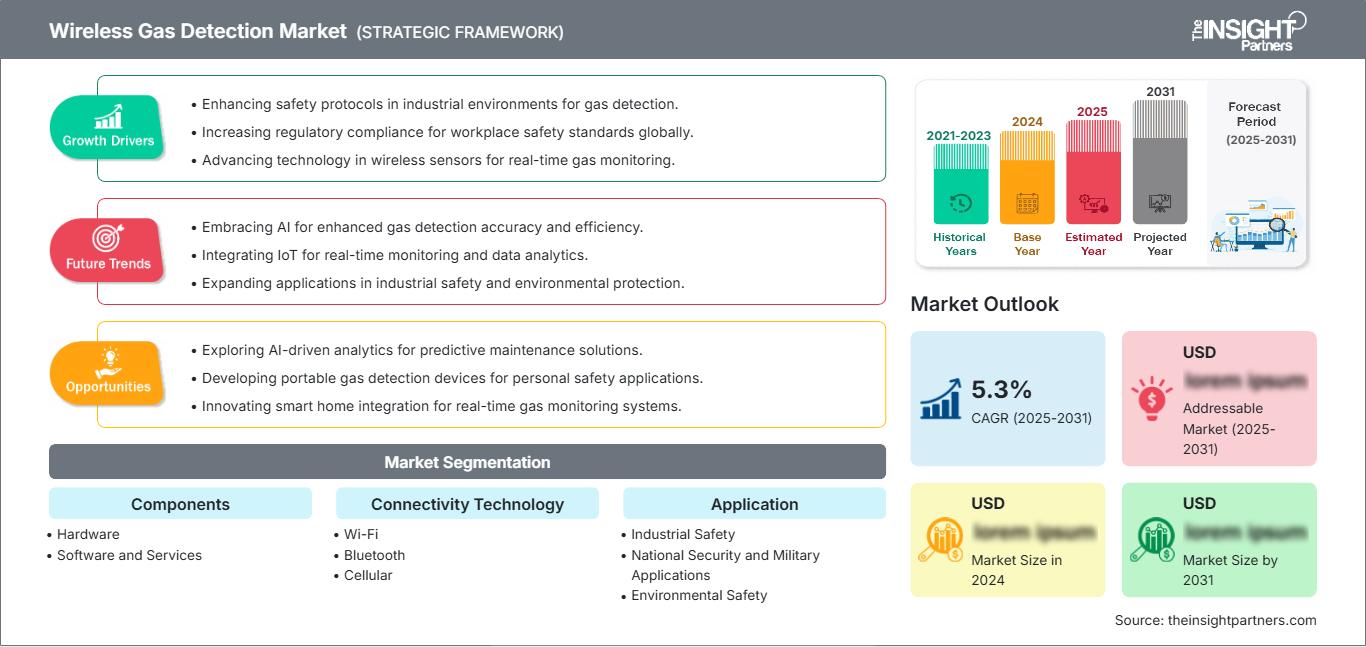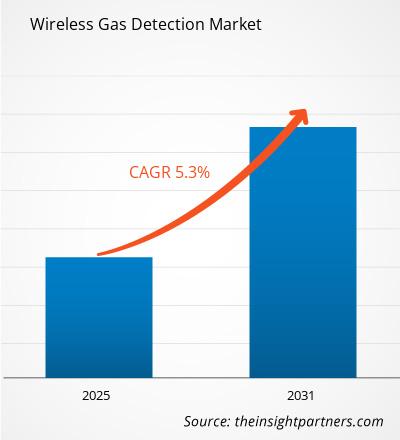Le marché de la détection de gaz sans fil devrait enregistrer un TCAC de 5,3 % entre 2025 et 2031, avec une taille de marché passant de XX millions de dollars américains en 2024 à XX millions de dollars américains d'ici 2031.
Le rapport est segmenté par composants (matériel, logiciels et services), technologie de connectivité (Wi-Fi, Bluetooth, cellulaire et bande ISM sans licence), application (sécurité industrielle, sécurité nationale et applications militaires, et sécurité environnementale), utilisateur final (pétrole et gaz, chimie et pétrochimie, électricité et services publics, mines et métaux, gouvernement et armée). L'analyse mondiale est ensuite ventilée au niveau régional et par principaux pays. Le rapport offre la valeur en USD pour l'analyse et les segments ci-dessus.
Objectif du rapport
Le rapport sur le marché de la détection de gaz sans fil de The Insight Partners vise à décrire le paysage actuel et la croissance future, les principaux facteurs moteurs, les défis et les opportunités. Cela fournira des informations à diverses parties prenantes commerciales, telles que :
- Fournisseurs/fabricants de technologie : pour comprendre l’évolution de la dynamique du marché et connaître les opportunités de croissance potentielles, leur permettant de prendre des décisions stratégiques éclairées.
- Investisseurs : pour effectuer une analyse complète des tendances concernant le taux de croissance du marché, les projections financières du marché et les opportunités qui existent tout au long de la chaîne de valeur.
- Organismes de réglementation : pour réglementer les politiques et surveiller les activités du marché dans le but de minimiser les abus, de préserver la confiance des investisseurs et de maintenir l’intégrité et la stabilité du marché.
Composants de segmentation du marché de la détection de gaz sans fil
- Matériel
- Logiciels et services
Technologie de connectivité
- Wi-Fi
- Bluetooth
- Cellulaire
- Bande ISM sans licence
Application
- Sécurité industrielle
- Applications de sécurité nationale et militaires
- Sécurité environnementale
Utilisateur final
- Pétrole et gaz
- Produits chimiques et pétrochimiques
- Énergie et services publics
- Mines et métaux
- Gouvernement et armée
Vous bénéficierez d’une personnalisation sur n’importe quel rapport - gratuitement - y compris des parties de ce rapport, ou une analyse au niveau du pays, un pack de données Excel, ainsi que de profiter d’offres exceptionnelles et de réductions pour les start-ups et les universités
Marché de la détection de gaz sans fil: Perspectives stratégiques

-
Obtenez les principales tendances clés du marché de ce rapport.Cet échantillon GRATUIT comprendra une analyse de données, allant des tendances du marché aux estimations et prévisions.
Moteurs de croissance du marché de la détection de gaz sans fil
- Demande croissante de sécurité au travail : Face à la sensibilisation croissante à la sécurité au travail, notamment dans les environnements dangereux comme les usines de fabrication, les champs pétroliers et gaziers et les industries chimiques, les systèmes de détection de gaz sans fil deviennent essentiels. Ces systèmes assurent une surveillance en temps réel des niveaux de gaz, contribuant ainsi à détecter les fuites et à prévenir les accidents tels que les explosions, les incendies ou l'exposition à des substances toxiques. L'importance croissante accordée aux réglementations en matière de santé et de sécurité des employés favorise l'adoption de technologies de détection de gaz sans fil.
- Croissance des réglementations environnementales : Des réglementations environnementales plus strictes poussent les industries à adopter des solutions capables de surveiller et d'atténuer les émissions de gaz dangereux. Les systèmes de détection de gaz sans fil permettent une surveillance continue et à distance de la qualité de l'air et des gaz toxiques dans les environnements industriels, garantissant ainsi le respect des normes environnementales. Ce moteur est particulièrement fort dans des secteurs tels que le pétrole et le gaz, l'exploitation minière et le traitement des eaux usées, où les émissions de gaz sont une préoccupation.
Tendances futures du marché de la détection de gaz sans fil
- Intégration avec l'IoT et les technologies cloud : la tendance à intégrer des détecteurs de gaz sans fil aux plateformes de l'Internet des objets (IoT) et aux systèmes cloud gagne du terrain. Ces systèmes permettent la collecte de données en temps réel, la surveillance à distance et l'analyse prédictive. En tirant parti de l'IoT, les entreprises peuvent recevoir des alertes en temps réel, visualiser les tendances et analyser les concentrations de gaz où qu'elles se trouvent, améliorant ainsi la sécurité et l'efficacité opérationnelle.
- Focus sur les dispositifs de détection de gaz portables et portables : la tendance est croissante aux dispositifs de détection de gaz portables et portables, en particulier pour les travailleurs dans des environnements dangereux. Ces dispositifs portables offrent une protection personnelle en alertant les individus de la présence de gaz nocifs tels que le monoxyde de carbone, le méthane ou le sulfure d'hydrogène. Cette tendance reflète le besoin croissant de solutions mobiles permettant aux travailleurs de se déplacer librement tout en garantissant leur sécurité dans des environnements dynamiques.
Opportunités de marché pour la détection de gaz sans fil
- Expansion dans le secteur pétrolier et gazier : L’industrie pétrolière et gazière représente une opportunité significative pour le marché de la détection de gaz sans fil. Compte tenu des risques inhérents aux fuites et aux explosions de gaz, le besoin de systèmes de surveillance efficaces est crucial. La détection de gaz sans fil peut améliorer la surveillance dans les zones reculées et sur les plateformes offshore, renforçant ainsi la sécurité des travailleurs et l’efficacité opérationnelle. L’accent mis par l’industrie sur la sécurité et la conformité crée un marché en pleine croissance pour ces technologies.
- Adoption dans les villes et infrastructures intelligentes : Avec l’essor des villes intelligentes, la demande de technologies garantissant la sécurité publique et la surveillance environnementale augmente. Les systèmes de détection de gaz sans fil peuvent être intégrés aux infrastructures des villes intelligentes pour une surveillance continue de la qualité de l’air et des gaz dangereux dans les espaces publics, les systèmes de transport et les zones industrielles. Cela représente une opportunité prometteuse pour étendre l’utilisation des détecteurs de gaz sans fil en milieu urbain.
Aperçu régional du marché de la détection de gaz sans fil
Les tendances régionales et les facteurs influençant le marché de la détection de gaz sans fil tout au long de la période de prévision ont été analysés en détail par les analystes de The Insight Partners. Cette section aborde également les segments et la géographie du marché de la détection de gaz sans fil en Amérique du Nord, en Europe, en Asie-Pacifique, au Moyen-Orient et en Afrique, ainsi qu'en Amérique du Sud et en Amérique centrale.
Portée du rapport sur le marché de la détection de gaz sans fil
| Attribut de rapport | Détails |
|---|---|
| Taille du marché en 2024 | US$ XX million |
| Taille du marché par 2031 | US$ XX Million |
| TCAC mondial (2025 - 2031) | 5.3% |
| Données historiques | 2021-2023 |
| Période de prévision | 2025-2031 |
| Segments couverts |
By Composants
|
| Régions et pays couverts |
Amérique du Nord
|
| Leaders du marché et profils d'entreprises clés |
|
Densité des acteurs du marché de la détection de gaz sans fil : comprendre son impact sur la dynamique commerciale
Le marché de la détection de gaz sans fil connaît une croissance rapide, portée par une demande croissante des utilisateurs finaux, due à des facteurs tels que l'évolution des préférences des consommateurs, les avancées technologiques et une meilleure connaissance des avantages du produit. Face à cette demande croissante, les entreprises élargissent leur offre, innovent pour répondre aux besoins des consommateurs et capitalisent sur les nouvelles tendances, ce qui alimente la croissance du marché.

- Obtenez le Marché de la détection de gaz sans fil Aperçu des principaux acteurs clés
- Analyse historique (2 ans), année de base, prévision (7 ans) avec TCAC
- Analyse PEST et SWOT
- Taille du marché Valeur / Volume - Mondial, Régional, Pays
- Industrie et paysage concurrentiel
- Ensemble de données Excel
Rapports récents
Rapports connexes
Témoignages
Raison d'acheter
- Prise de décision éclairée
- Compréhension de la dynamique du marché
- Analyse concurrentielle
- Connaissances clients
- Prévisions de marché
- Atténuation des risques
- Planification stratégique
- Justification des investissements
- Identification des marchés émergents
- Amélioration des stratégies marketing
- Amélioration de l'efficacité opérationnelle
- Alignement sur les tendances réglementaires






















 Obtenez un échantillon gratuit pour - Marché de la détection de gaz sans fil
Obtenez un échantillon gratuit pour - Marché de la détection de gaz sans fil